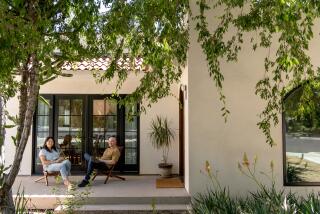Cooking up some charm
- Share via
ADMIRERS of the Arts and Crafts movement and the bungalows of the early 20th century will find a place of honor on the coffee table for this book. Which is not to say it is without practical use. “The New Bungalow Kitchen,” by architect Peter LaBau, is aimed at the homeowner or builder who wants to incorporate modern convenience without sacrificing the charm of traditional bungalow style.
First, a bit of history: The bungalow kitchens from 1900 to 1920 were typically small by today’s standards, and separated from the rest of the home. Although dark wood accented the formal rooms, the sparsely furnished kitchen stood off to the back, painted white to make cleaning easier and maximize the available light.
Built-in cabinetry, gas and electricity transformed postwar kitchens. In the bungalow, wood cabinets and trim were used to help integrate the kitchen with the rest of the house, and modern conveniences such as the gas range and hot running water made the space more efficient.
Today’s bungalow-style kitchen is larger, incorporated in a more open floor plan, and in new construction is often the heart of the home.
The traditional elements of the style are outlined in the book. They include the generous use of wood, windows including casement and stained glass, and handmade tile accents. Linoleum was the flooring of choice in the early bungalow kitchen and is enjoying a resurgence today, thanks to its organic pedigree.
Wood is widely used in cabinetry and moldings, built-in furniture, windows and -- in newer homes -- flooring. It adds “warmth,” writes LaBau, whose firm specializes in building and renovating traditional homes.
The book covers kitchen renovation in older homes and interpretations of the style in newer homes. Chapters are devoted to the entire process, including layout design, appliance and lighting options and details such as cabinet latches.
Informative “Bungalow Basics” sidebars that go into detail about trim, salvage, history, tile and a host of other subjects dot the pages.
Modern conveniences blend seamlessly with the old in most cases. State-of-the-art stainless-steel appliances work well with the bungalow aesthetic of beauty and functionality, says the author. Judging from the excellent photographs, the mix of textures -- wood and steel, the juxtaposition of granite countertops with period faucets -- are quite striking.
Other marriages don’t work so well; for example, recessed lighting in a tin ceiling.
This is not a do-it-yourself book. When an author says tearing out a false ceiling is “exciting,” reach for your wallet. But for a fountain of ideas to present to your contractor or architect, it’s a good resource.
And speaking of resources, there is a comprehensive, illustrated list at the end of the book. It includes just about everything: architects, contractors, appliances and where to find the doorknobs shown in most of the 17 individual projects featured in the book. However, the guide does not include page numbers, which would have been helpful.
--
More to Read
Sign up for our Book Club newsletter
Get the latest news, events and more from the Los Angeles Times Book Club, and help us get L.A. reading and talking.
You may occasionally receive promotional content from the Los Angeles Times.








